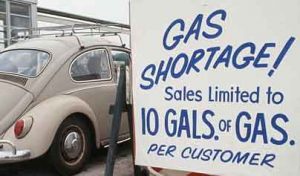
I was in junior high when the United States implemented odd-even gas rationing in 1979 and 1980. I remember sitting in the back seat of the family station wagon for hours, waiting for our turn to fill up. When we finally got to the pump, my father cursed the rise in fuel prices. Every week seemed to see the prices jump up from the week before. The price for a gallon of regular gas went from $0.63 in 1978 to more than double, $1.31, by 1981. We saw a similar jump begin in Spring 2010 when the price of a gallon of fuel went from $2.35 to $3.53 in less than 18 months. Fuel surcharges became a common fee associated with air travel, taxi cabs, and freight shipments to recoup the cost of the seemingly endless rise in the cost of moving people and things around the country and the world. Evidence is mounting that we are heading that way yet again.
A recent Car & Driver article has seen a rise of $0.17 a gallon for gasoline since the beginning of May, and predicts, based on information from AAA, that we can expect gas prices to go over $3 a gallon this summer, with 19% of gas stations in the United States already at the $3.01 a gallon mark. Diesel is seeing the same rise as unleaded. The May 1, 2018 Department of Energy report showed diesel at its highest rate since 2014. The average cost for a gallon of diesel was $3.16, up $0.18 since January.  The rise in prices is leading most freight carriers to implement or raise fuel surcharges. UPS, which had lowered its fuel surcharge at the beginning of May, will be raising the rate from 16.75% to 18% on July 5. FedEx has raised their fuel surcharge rate from 23.5% in January to 25% last week. As the summer fuel prices climb, prepare for those surcharges to increase as well, increasing the cost to ship everything, from a single box to LTL to a full truckload shipment. Compound that with a shortage in truck drivers, and freight charges could really surge the back half of this year.
The rise in prices is leading most freight carriers to implement or raise fuel surcharges. UPS, which had lowered its fuel surcharge at the beginning of May, will be raising the rate from 16.75% to 18% on July 5. FedEx has raised their fuel surcharge rate from 23.5% in January to 25% last week. As the summer fuel prices climb, prepare for those surcharges to increase as well, increasing the cost to ship everything, from a single box to LTL to a full truckload shipment. Compound that with a shortage in truck drivers, and freight charges could really surge the back half of this year.
Travel this summer will be impacted as well. With the cost of gasoline rising, an recent survey done by Gas Buddy shows only 58% of people planning on a driving v acation this summer, compared to 82% last year. Airlines, which are forbidden by law to add a fuel surcharge, are beginning to debate an increase in ticket costs. Even if you decide to skip the vacation this year, the cost of commuting to work will go up. Most Americans live within 25 miles of their job, and the average car on the road gets 24.7 miles per gallon. If gasoline prices do rise upwards of $0.30 a gallon this summer, the average commuter will spend an additional $41.08 just getting to and from work between Memorial Day and Labor Day. That could translate to one less trip to the water park or one fewer cookout. As for me, I’m going to see if I can talk my husband into that new Tesla. Wish me luck!
acation this summer, compared to 82% last year. Airlines, which are forbidden by law to add a fuel surcharge, are beginning to debate an increase in ticket costs. Even if you decide to skip the vacation this year, the cost of commuting to work will go up. Most Americans live within 25 miles of their job, and the average car on the road gets 24.7 miles per gallon. If gasoline prices do rise upwards of $0.30 a gallon this summer, the average commuter will spend an additional $41.08 just getting to and from work between Memorial Day and Labor Day. That could translate to one less trip to the water park or one fewer cookout. As for me, I’m going to see if I can talk my husband into that new Tesla. Wish me luck!
